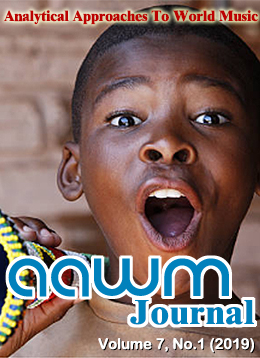 |
|
 |
 |
|
 |
 |
|
AAWM JOURNAL Volume 7, No. 1 (2019) |
 |
 |
| Volume 7, No. 1 (2019) |
|
 |
 |
| Timely Negotiations: Formative Interactions in Cyclic Duets |
| John Roeder (University of British Columbia) |
|
Susanne Fürniss’s (2006) magisterial survey of Aka polyphony analyzes a remarkable duet in which each singer draws material from a regularly repeating cycle but varies it on the fly to complement her partner’s likewise varying repetitions. This texture of two independently cycling but interacting voices, although well-suited to the Aka’s conception of musical structure, is not unique to them; indeed, examples from many traditional cultures have been recorded. In some instances, the musicians may be heard coordinating their variations to forge large-scale musical form out of what would otherwise be uniform repetition. This paper analyzes three items that illustrate the potential of such equal-voice cyclic duets to support formative interactions of timbre, timing and grouping that are not possible in monophony and not so effective in other polyphonic textures. In a funeral lamentation from the Solomon Islands, the singers’ timbral variations set up and realize large-scale formal articulations. In a flirtatious song of the Ecuadorian Amazon, as the singers repeat irregularly timed cycles at different tempos, they adjust the placement of their respective beats to create phases of greater or lesser synchrony and changing leader-follower relationships. Lastly, in a communal dance of French Guyana, one part adjusts its timing to accommodate the addition and deletion of events by the other, creating an unpredictable, dramatically charged process that they gradually direct towards a stable regular groove. Like the Aka duet, these compositions transform what might be a rote, mechanical procedure into a lively vehicle for distinctive formal and expressive effects....more >>
|
|
 |
 |
| Generative principles of dance music in Central Calabria |
| Christian Ferlaino |
|
This paper discusses the generative principles of dance music for eight-bass diatonic button accordion in Central Tyrrhenian Calabria, in southern Italy, and offers insight into the concepts of modularity and micro-variation. It describes a highly formalized real-time process of melodic recombination and variation. Through corpus-based analyses supported by extensive ethnographic and auto-ethnographic data, this article discusses the music in relation to the emic conceptual framework in which it is generated.
In the first part of this article, I introduce the object of research, the methodology and the theoretical framework. Then, I briefly present the instrument and introduce the melodic materials of dance music as conceptualized by the tradition bearers. Next I analyze two pieces of dance music: fina and quattrubassi. The analysis of fina provides insight into modular processes that revolve around a single melodic shape. This section also describes the processes of real-time manipulation of the musical materials. The analysis of quattrubassi describes modularity in more complex tunes, in which different orders of melodic fragments and musical elements are recombined into more extended melodic constructions. This section compares performances from different players and illustrates how the shared tunes vary considerably among the musicians of the area. A final part discusses the significance of the musical materials in defining the identity of the tunes. I identify the defining factors of the tunes’ identities in some elements which appear to be more important than the musical constructions of which they are part.
My article brings modularity and micro-variation to the attention of the international scientific community; it also contributes to Italian studies on modularity by looking into the generative principles of an under-studied repertoire. ...more >>
|
|
 |
 |
| Micro-temporal Interactions in Sitar and Tabla Duo Performance: An Analysis of a Vilambit Performance by Pt. Nikhil Banerjee and Zamir Ahmed Khan |
| Alec Cooper |
|
This paper presents a micro-temporal analysis of a complete, 34-minute long vilambit (i.e., slow) sitar and tabla duo performance by Pt. Nikhil Banerjee and Zamir Ahmed Khan. The analysis involved extracting the onsets of approximately 3,000 musical sound events—the deliberate manual strikes on the sitar strings and tabla skins—produced on the metric level of ‘maximal pulse salience’ (i.e. half-mātrā) in the course of performance. These data were used to analyze performers’ tempo fluctuations, isochronization, mean asynchronization, and interpersonal entrainment throughout the vilambit and across various formal sub-sections. The analysis reported here is original in that it tackles an extended duration of a North Indian instrumental duo performance, with the aim of relating micro-temporal patterns to other variables such as alternating musical roles, surface rhythm, metric cycle, and formal development. Results reveal consistent patterns of micro-temporal interaction, including: (i) linear micro-fluctuations in tempo relating to the performers’ alternating roles as soloist and accompanist; (ii) cyclical micro-fluctuations in tempo according to metric framework; (iii) higher isochronization values when performers act as soloists; (iv) higher mean asynchronization values during tabla solos; (v) persistent phase relationships according to musical role; (vi) marked changes in synchronization and coupling according to surface rhythm and formal development; and (vii) cyclical patterns in levels of synchronization, phase, and coupling relating to metric framework. The study of sitar and tabla performers’ micro-temporal interactions thus exposes a new functional level in which musical roles, expression, and formal development are enacted in this genre ...more >>
|
|
 |
 |
| Remembering Melodies from Another Culture: Turkish and American Listeners Demonstrate Implicit Knowledge of Musical Scales |
| Timothy Justus, Charles M. Yates, Nart Bedin Atalay, Nazike Mert, and Meagan E. Curtis |
|
Beyond the major-minor tonality that characterizes classical and contemporary Western musical genres, Turkish classical and folk music offer experimental psychologists a rich modal system in which cognition, development, and enculturation can be studied. Here, we present a cross-cultural experiment concerning implicit knowledge of musical scales. Five groups of participants—American musicians and nonmusicians, Turkish musicians and nonmusicians, and Turkish classical and folk music listeners—were asked to listen to brief melodies composed using the member tones of either the major scale or the rast makam, a microtonal mode found within Turkish classical and folk genres with no equivalent in Western music. Following each melody, participants were asked to identify whether a probe tone had been presented in the melody, providing confidence ratings on a six-point scale. In general, participants’ short-term memory was influenced by implicit knowledge of musical scales, with the major scale eclipsing the rast makam even in listeners experienced with Turkish genres. Prior work and future directions in cross-cultural music cognition research are discussed....more >>
|
|
|
 |
|
 |
 |
|



